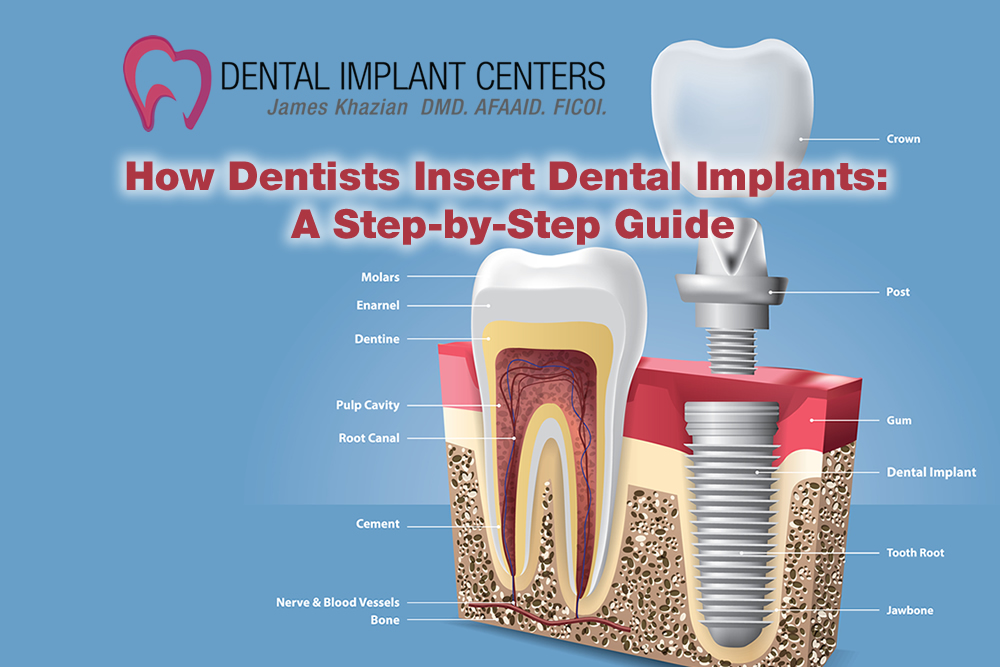Summary
The process of inserting dental implants may seem complex, but it is a well-established and highly effective procedure performed by skilled dentists and oral surgeons.
How Dentists Insert Dental Implants: A Step-by-Step Guide
Dental implants have become a go-to solution for replacing missing teeth, offering durability, functionality, and a natural appearance. If you’re considering dental implants, understanding the process of how dentists insert them can help ease any concerns and prepare you for the journey. This article breaks down the procedure into clear steps, from the initial consultation to the final placement of the implant.
1. Initial Consultation and Planning
The process begins with an initial consultation with your dentist or implant specialist. During this visit:
- Oral Examination: The dentist evaluates your overall oral health, including the condition of your gums and jawbone.
- Imaging Tests: X-rays or 3D scans of your mouth and jaw are taken to assess bone density and determine the optimal implant placement.
- Customized Treatment Plan: Based on your specific needs, the dentist creates a personalized plan detailing the number of implants needed, type of restoration, and any preparatory procedures required.
2. Preparatory Procedures (If Necessary)
Before the actual implant insertion, some patients may need additional treatments:
- Tooth Extraction: If the damaged tooth is still present, it is carefully removed.
- Bone Grafting: For patients with insufficient bone density, bone grafting is done to strengthen the jawbone. This ensures the implant has a stable foundation. The healing process for grafting can take several weeks to months.
- Sinus Lift: If implants are being placed in the upper jaw near the sinus area, a sinus lift might be performed to create more space for the implant.
3. Placing the Dental Implant
The core of the procedure involves surgically placing the implant into the jawbone. Here’s how it’s done:
- Anesthesia: Local anesthesia or sedation is used to ensure the procedure is pain-free and comfortable.
- Incision in the Gum: The dentist makes a small incision in the gum to expose the underlying jawbone.
- Drilling into the Bone: A precise hole is drilled into the jawbone where the implant will be placed.
- Insertion of the Implant: The titanium implant post is screwed or tapped into the prepared hole. Titanium is used because it is biocompatible and fuses well with the bone.
- Suturing the Gum: The gum tissue is stitched back over the implant, leaving it to heal and integrate with the jawbone.
4. Osseointegration: Healing Phase
After the dental implant is placed, the process of osseointegration begins. This is where the bone grows around the implant, anchoring it firmly in place. This phase is crucial and typically takes 3-6 months. During this time:
- The implant gains stability and becomes a permanent part of your jaw.
- Temporary restorations may be provided to maintain aesthetics and functionality.
5. Attaching the Abutment
Once osseointegration is complete, a minor surgical procedure is performed to place an abutment:
- Reopening the Gum: The dentist makes a small incision to expose the implant.
- Attaching the Abutment: The abutment, a connector piece, is secured to the implant. This serves as the base for the artificial tooth.
- Gum Healing: The gums are allowed to heal around the abutment for a few weeks.
6. Placing the Crown (Artificial Tooth)
The final step is attaching the custom-made crown:
- Taking Impressions: Impressions of your teeth are taken to design a crown that matches the shape, size, and color of your natural teeth.
- Fabricating the Crown: The crown is crafted in a dental lab, ensuring it blends seamlessly with your smile.
- Crown Placement: The crown is securely attached to the abutment, completing the restoration.
7. Post-Procedure Care and Follow-Up
After the procedure, maintaining good oral hygiene is essential to ensure the longevity of your dental implants:
- Brush and floss regularly to prevent plaque buildup.
- Avoid hard or sticky foods that could damage the implant.
- Attend routine dental check-ups to monitor the condition of your implants.
Benefits of Dental Implants
Dental implants offer numerous advantages:
- Durability: Implants can last a lifetime with proper care.
- Functionality: They feel and function like natural teeth, allowing you to eat and speak comfortably.
- Aesthetics: Implants restore the appearance of your smile, boosting confidence.
- Bone Health: By stimulating the jawbone, implants prevent bone loss and maintain facial structure.
Conclusion
The process of inserting dental implants may seem complex, but it is a well-established and highly effective procedure performed by skilled dentists and oral surgeons. Each step is carefully designed to ensure a successful and long-lasting result. Whether you’re replacing a single tooth or multiple teeth, dental implants can restore your smile, functionality, and quality of life. Consult with your dentist to see if dental implants are the right solution for you.


